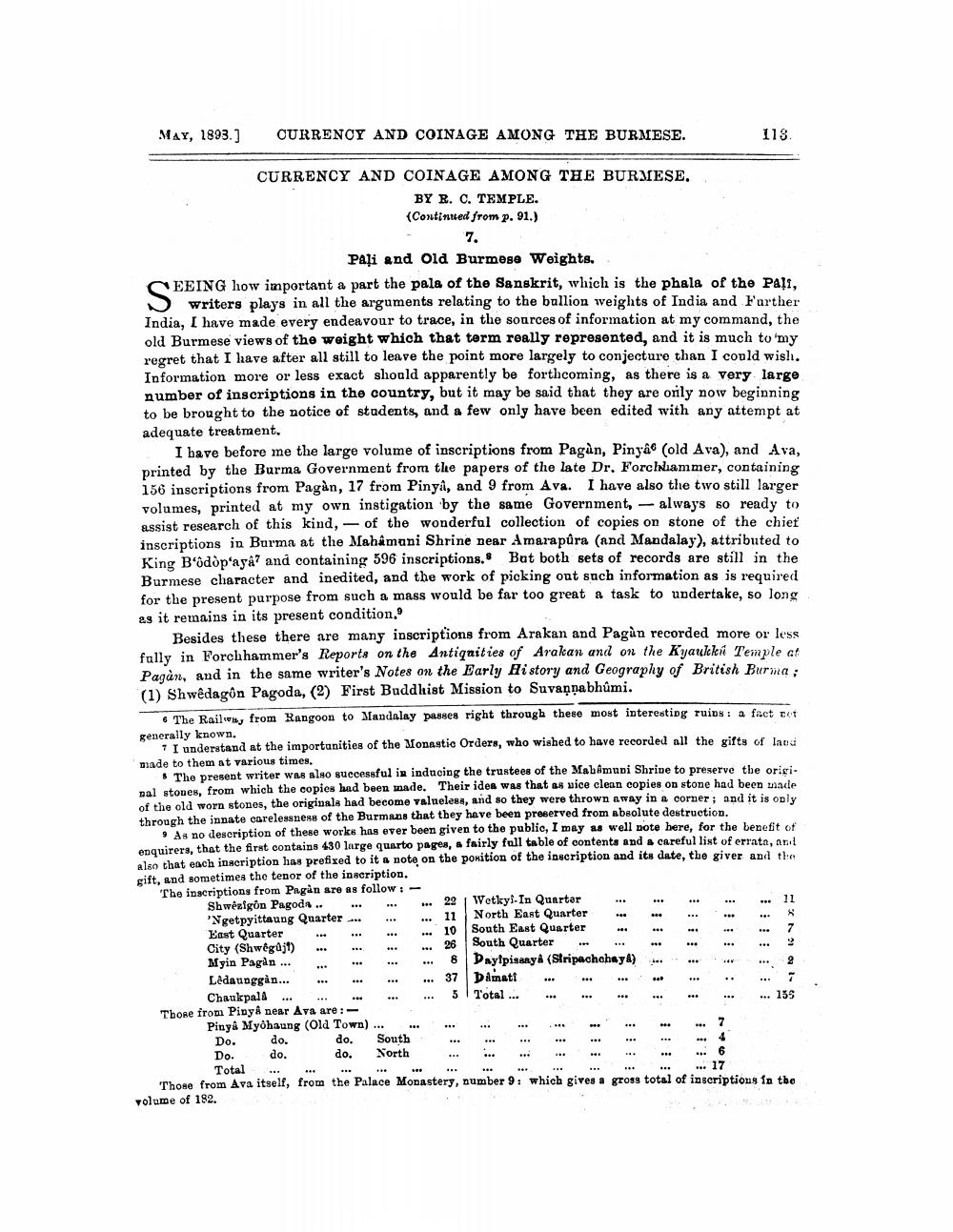________________
CURRENCY AND COINAGE AMONG THE BURMESE.
113
CURRENCY AND COINAGE AMONG THE BURMESE.
BY R. C. TEMPLE. (Continued from p. 91.)
7.
Pali and Old Burmese Weights. CEEING how important a part the pala of the Sanskrit, which is the phala of the Pali,
writers plays in all the arguments relating to the ballion weights of India and Further India, I have made every endeavour to trace, in the sources of information at my command, the old Burmese views of the weight which that term really represented, and it is much to 'my regret that I have after all still to leave the point more largely to conjecture than I could wish. Information more or less exact should apparently be forthcoming, as there is a very large number of inscriptions in the country, but it may be said that they are orily now beginning to be brought to the notice of students, and a few only have been edited with any attempt at adequate treatment.
I have before me the large volume of inscriptions from Pagan, Pinya (old Ava), and Ava, printed by the Burma Government from the papers of the late Dr. Forchammer, containing 156 inscriptions from Pagàn, 17 from Pinya, and 9 from Ava. I have also the two still larger volumes, printed at my own instigation by the same Government, - always so ready to assist research of this kind,- of the wonderful collection of copies on stone of the chiet inscriptions in Burma at the Mahamani Shrine near Amarapura (and Mandalay), attributed to King B‘odòp'aya? and containing 596 inscriptions. But both sets of records are still in the Burmese character and inedited, and the work of picking out such information as is required for the present purpose from such a mass would be far too great a task to undertake, so long as it remains in its present condition.
Besides these there are many inscriptions from Arakan and Pagùn recorded more or less fully in Forchhammer's Reports on the Antiqaities of Arakan and on the Kyaukkii Temple at Pagàn, and in the same writer's Notes on the Early History and Geography of British Burma; (1) Shwedagon Pagoda, (2) First Buddhist Mission to Suvannabhúmi.
The Railway from Rangoon to Mandalay passes right through these most interesting ruins: a fact tt generally known.
1 I understand at the importanities of the Monastic Orders, who wished to have recorded all the gifts of latu made to them at various times,
The present writer was also successful in inducing the trustees of the Mabimuni Shrine to preserve the origi. nal stones, from which the copies had been made. Their idea was that as vice clean copies on stone had been made of the old worn stones, the originals had become valueless, and so they were thrown away in a corner; and it is only through the innate carelessness of the Burmans that they have been preserved from absolute destruction.
As no description of these works has ever been given to the public, I may as well note here, for the benefit of enquirers, that the first contains 430 large quarto pagea, a fairly fall table of contents and a careful list of errata, and also that each inscription has prefixed to it a note on the position of the inscription and its date, the giver and the gift, and sometimes the tenor of the inscription. The inscriptions from Pagàn are as follow:Shếzigon Pagoda . . .
... 22 Wetky-In Quarter ... ... 'Ngetpyittaung Quarter ... ...
11 North East Quarter East Quarter
South East Quarter City (Shwégûjt)
South Quarter
.. Myin Pagin ...
8 Daylpisanya (Stripachchaya) Ladaunggan... ...
Dimatt .. . .. Chaukpall ... ...
5 Total ... ... ... ... Tbore from Pinyå near Ava are:
Pinya Myöhaung (Old Town) ... ... ... ... ... ... . Do. do. do. South ... .. Do do. do. North ... ... .. . . .
6 Total ... .. ... ..
... 17 Those from Ava itself, from the Palace Monastery, number 9: which gives a gross total of inscriptions in the volume of 182.
*
10




